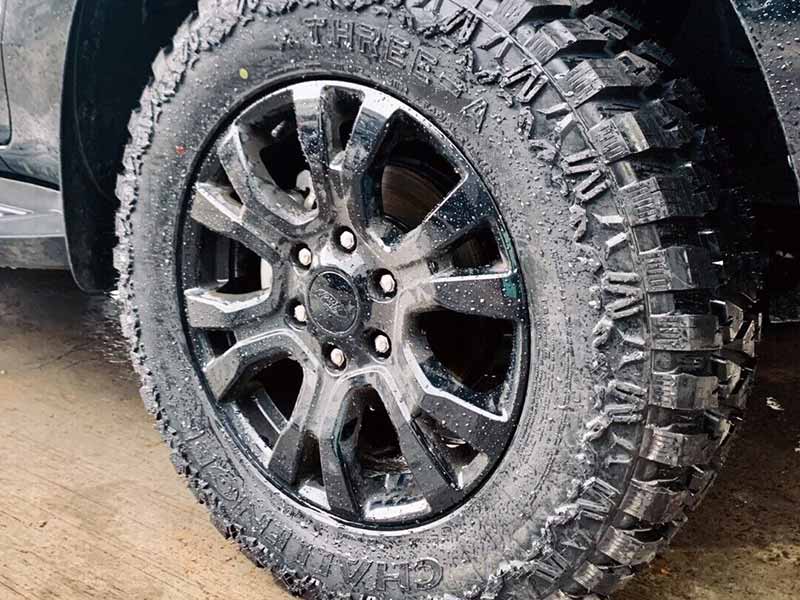Have you ever looked at your vehicle’s tires and wondered what all those numbers mean? Well, you’re not alone. Tires can be confusing, with their mix of numbers and letters, but understanding them is crucial for ensuring the best performance and safety of your vehicle.
285 Tires In Inches
A 285mm tire is approximately 11.22 inches wide. This measurement refers to the tire’s section width, which is the linear distance between the outer sidewalls of an uninflated tire.
In this article, we will delve into the specifics of tire measurements – section width, aspect ratio, and wheel diameter – and explain how to convert these from metric to imperial units. We’ll also guide you through calculating the overall height of a tire, an essential factor for anyone considering larger tires for their truck or SUV.
Understanding Tire Measurements
When it comes to tires, there’s more than meets the eye. Sure, they’re round and black, but the numbers and letters printed on their sidewalls tell a story – a story about how they’ll fit, perform, and feel on your vehicle. Let’s demystify these numbers and understand the three critical tire measurements: section width, aspect ratio, and wheel diameter.
Section Width
- What Is It?: Think of section width as the width of your tire’s footprint. It’s the distance in millimeters from one outer sidewall to the other, measured when the tire is not installed on a vehicle.
- Why It Matters:
- Vehicle Fit: A tire that’s too wide can rub against the car’s body or suspension; too narrow, and it might not support the weight of the vehicle adequately.
- Performance: Wider tires generally provide better traction and handling, but they can also affect fuel efficiency.
Aspect Ratio
- The Lowdown: Aspect ratio is a bit less straightforward. It’s the height of the tire’s sidewall, but expressed as a percentage of the section width. So, a higher number doesn’t always mean a taller tire – it depends on the width.
- Impact on Your Ride:
- Ride Comfort: A higher aspect ratio usually means more cushion between you and the road, leading to a smoother ride.
- Handling: Lower aspect ratios can improve handling, making them a favorite for sports cars.
Wheel Diameter
- Simply Put: This one’s easy – it’s the diameter of the wheel that the tire is designed to fit, measured in inches.
- Why It Counts:
- Compatibility: The right wheel diameter ensures that the tire fits your wheel correctly. No compromises here.
- Aesthetics and Performance: Larger wheels can enhance the look of your vehicle and can offer better handling, but they might also make for a less comfortable ride.
Section Width Conversion Calculator
Converting 285mm to Inches
Now that we’ve got a grip on the basics, let’s roll into the nitty-gritty of converting our tire width from millimeters to inches. Why inches, you ask? Well, it’s like speaking the same language as your wheels – most wheel diameters are measured in inches. So, let’s break down this conversion with our example: a 285mm section width tire.
Step-by-Step Conversion
- Grab Your Calculator: To convert millimeters to inches, we use a simple conversion factor. One inch equals 25.4 millimeters.
- The Math: Take the section width in millimeters (in our case, 285mm) and divide it by 25.4.
- The Result: 285mm / 25.4mm per inch ≈ 11.22 inches
What This Number Tells Us
- Tire Width in Inches: Your tire’s section width is about 11.22 inches wide.
- Practical Insights:
- Fitment: Knowing this width in inches helps in understanding if this tire will fit your vehicle, especially if you’re dealing with wheel sizes that are also measured in inches.
- Comparison: It’s easier to compare tire sizes when you convert them to a standard unit, especially if you’re shopping around or considering a change in tire size.
Tire Height Calculator
Calculating Tire Height
Alright, let’s shift gears and talk about tire height. This is a big deal, especially if you’re in the market for larger tires for your truck or SUV. Understanding tire height is key to ensuring you don’t end up with tires that are too tall or short for your vehicle. So, how do you figure out how tall a tire is? It’s not as straightforward as width, but with a little math, we can get there.
The Formula for Tire Height
To calculate the overall height of a tire, we use a formula that might look a bit intimidating at first, but it’s actually pretty simple:
Tire Height=(Section Width×Aspect Ratio×2÷1000)+Wheel DiameterTire Height=(Section Width×Aspect Ratio×2÷1000)+Wheel Diameter
Let’s break this down using our 285mm section width tire as an example.
Example Calculation
- Choose Aspect Ratio and Wheel Diameter: Let’s say our tire has an aspect ratio of 75 and is designed to fit a 16-inch wheel.
- Convert Section Width to Meters: First, convert 285mm to meters (285mm = 0.285m) because our formula uses meters.
- Calculate Sidewall Height: Multiply the section width by the aspect ratio and then divide by 100 to get the height of one sidewall.
- 0.285m×75÷100=0.21375m0.285m×75÷100=0.21375m
- Double the Sidewall Height: Since there are two sidewalls (top and bottom), multiply the sidewall height by 2.
- 0.21375m×2=0.4275m0.21375m×2=0.4275m
- Add Wheel Diameter: Finally, add the wheel diameter (converted to meters) to get the overall tire height.
- 0.4275m+16inches0.4275m+16inches (Note: Convert 16 inches to meters, where 1 inch = 0.0254m)
- 0.4275m+0.4064m=0.8339m0.4275m+0.4064m=0.8339m
Understanding Tire Height
- The Final Result: Our 285/75/16 tire is approximately 0.834 meters or 32.83 inches tall.
- Why This Matters:
- Vehicle Clearance: Ensure there’s enough room in the wheel well.
- Speedometer Accuracy: Larger or smaller tires can affect how your speedometer reads.
- Ride Quality: The height can impact how your vehicle handles bumps and off-road terrain.

Practical Implications of Tire Measurements
When it comes to tires, the numbers are more than just measurements; they’re a gateway to understanding how your vehicle interacts with the road. The section width, aspect ratio, and wheel diameter are not just figures on a sidewall – they play a crucial role in your vehicle’s performance, safety, and efficiency. Let’s explore the practical implications of these tire measurements.
Impact on Vehicle Performance
- Handling and Stability: The width of your tires directly influences your vehicle’s handling. Wider tires offer more grip and stability, especially in turns and during high-speed maneuvers. However, if they’re too wide for your vehicle, they can lead to handling issues and increased wear.
- Speedometer Accuracy: Changing tire sizes can affect your speedometer reading. Larger tires cover more ground per revolution, which might result in your speedometer showing a slower speed than you’re actually traveling. It’s essential to recalibrate your speedometer if you change tire sizes significantly.
Fuel Efficiency and Ride Comfort
- Rolling Resistance: A wider tire can increase rolling resistance, which may lead to decreased fuel efficiency. It’s a trade-off between enhanced grip and potential extra fuel costs.
- Comfort: The aspect ratio of a tire, which indicates sidewall height, affects ride comfort. Tires with a higher aspect ratio have taller sidewalls and can absorb road imperfections better, leading to a smoother ride.
Safety Considerations
- Load Capacity and Air Pressure: Each tire is designed to carry a certain amount of weight. Overloading a tire or running it at incorrect air pressure can be dangerous. Always check the manufacturer’s recommendations.
- Tread Wear: Incorrect tire sizes can lead to uneven tread wear, reducing the lifespan of your tires and potentially affecting vehicle safety.
Tips for Selecting the Right Tire Size
- Consult Vehicle Manual: Your vehicle’s manual will have recommendations for tire sizes. Sticking to these specifications is usually the safest bet.
- Professional Advice: When in doubt, consult with a tire professional. They can provide insights tailored to your vehicle and driving needs, especially if you’re considering a significant change in tire size.
Legal and Regulatory Aspects
- Regulations: Some regions have legal restrictions on tire sizes, especially for trucks and SUVs. Ensure that your tire choices comply with local laws and regulations.
- Insurance: Be aware that changing tire sizes might affect your vehicle insurance. Some modifications can lead to higher premiums or even void your coverage.
Resources
Below are some links you may find helpful when learning about tires:
- Tire size equivalent chart for 33″, 35″, 37″ or 40″ tires – Tire Buyer
- 285/75R17 tire Size in inches and millimeters – Byways
Final Thoughts
Grasping the concepts of section width, aspect ratio, and wheel diameter, and learning how to convert and calculate these measurements, you are equipped to make informed decisions about your tires.
Whether you’re replacing old tires or considering an upgrade to larger tires for your truck or SUV, this knowledge is invaluable.
The right tires can significantly enhance your driving experience while ensuring your safety on the road.
Good luck and happy motoring.





